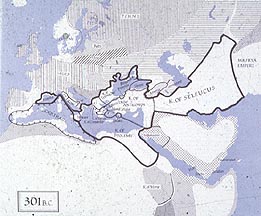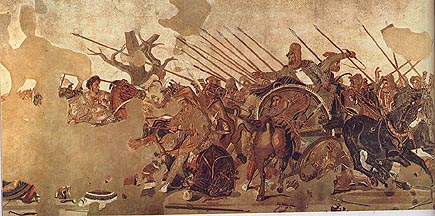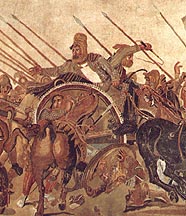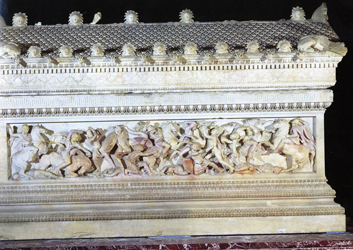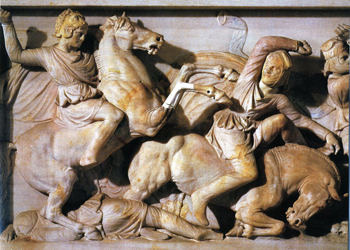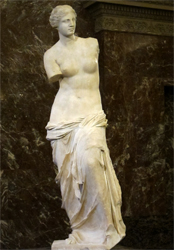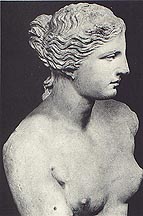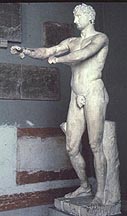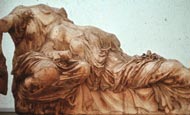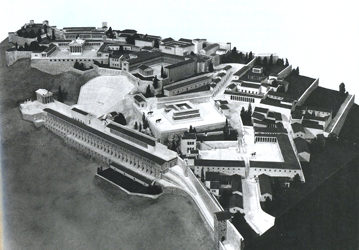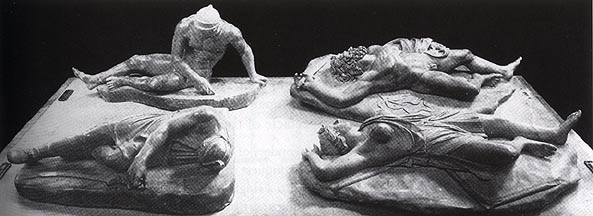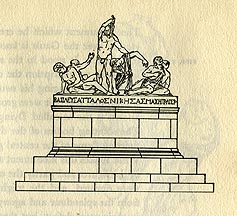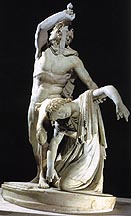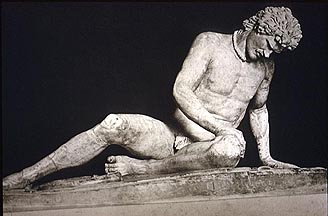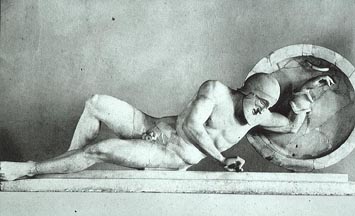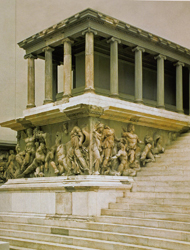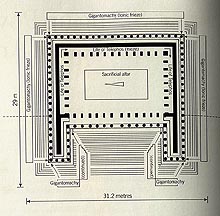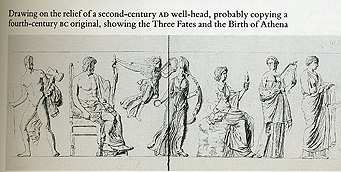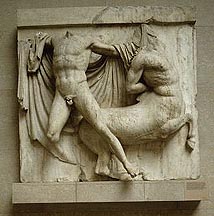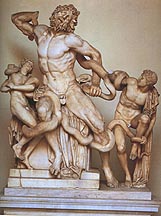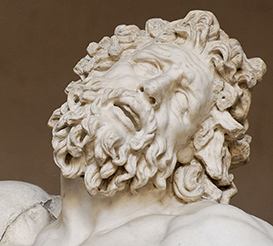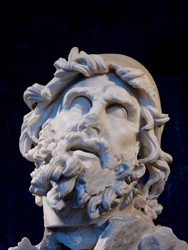Art Home | ARTH Courses | ARTH 209 Assignments
Hellenistic Art
|
Detail of Alexander riding Bucephalus from the Alexander mosaic. |
||
"Alexander Sarcophagus", probably made for Abdalonymos, King of Sidon, c. 320. Relief shows battle of Alexander against the Persians. The other side shows Alexander and Abdalonymos engaging in a hunt. |
||
Pergamon
We have already seen in Athens in the middle of the fifth century, how Pericles used art and cultural patronage as a way of demonstrating / constructing power. This is well manifested again during the Hellenistic period, especially in the kingdom of Pergamon. The Attalid kings of Pergamon tried to make this Asia Minor city the Athens of the east. This use of past monuments to lend authority to later monuments is an important theme in western art. A [chilling] example can be found in this Soldier's Memorial constructed by the Nazis in the late 1930's. This building's plan is directly imitating the Great Altar of Pergamon which had been brought back to Germany and housed in a special museum in Berlin, Germany's new capital.
The following
excerpt is from T. B. L. Webster, The Art of Greece: the Age of Hellenism,
p. 92: The most splendid and influential Middle Hellenistic city was Pergamon.
The last king of Pergamon, Attalos III, left his kingdom to Rome in 133 B.C.;
thus very large numbers of works of art came to Italy when his property was
auctioned. 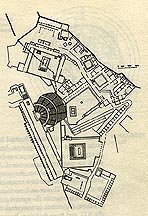 The
site is on a hill which rises steeply 300 metres above the coastal plain opposite
the island of Lesbos. One of Alexander's companions, Lysimachos, who set himself
up as king of Thrace and northern Asia Minor, deposited a large amount of
treasure in the natural stronghold of Pergamon and placed an officer, Philetairos,
in command. Philetairos deserted Lysimachos in 282 B.C. and from that time
Pergamon was under the suzerainty of Seleukos; Philetairos won a victory over
raiding Galatians or Gauls in 278 B.C. Philetairos' nephew, Eumenes I, made
himself independent in 263 B.C.; he was succeeded by his nephew Attalos I,
who ruled until 197 B.C. He again defeated the Gauls in 230 B.C. and made
an alliance with the Romans. His Western policy was carried on by his elder
son Eumenes II and by his younger son Attalos II. Finally Attalos III, son
of Eumenes II, who succeeded in 138 B.C., bequeathed his kingdom to Rome.
The
site is on a hill which rises steeply 300 metres above the coastal plain opposite
the island of Lesbos. One of Alexander's companions, Lysimachos, who set himself
up as king of Thrace and northern Asia Minor, deposited a large amount of
treasure in the natural stronghold of Pergamon and placed an officer, Philetairos,
in command. Philetairos deserted Lysimachos in 282 B.C. and from that time
Pergamon was under the suzerainty of Seleukos; Philetairos won a victory over
raiding Galatians or Gauls in 278 B.C. Philetairos' nephew, Eumenes I, made
himself independent in 263 B.C.; he was succeeded by his nephew Attalos I,
who ruled until 197 B.C. He again defeated the Gauls in 230 B.C. and made
an alliance with the Romans. His Western policy was carried on by his elder
son Eumenes II and by his younger son Attalos II. Finally Attalos III, son
of Eumenes II, who succeeded in 138 B.C., bequeathed his kingdom to Rome.
Attalos I
conceived of his capital as a center of culture and started the building which
was carried on by his successors. Like the Alexandrians, he set up a library
and was sufficiently successful for Ptolemy V to try and stop its development
by putting an embargo on the export of papyrus from Egypt; Eumenes II replied
by introducing parchment. The library and the theatre...were early additions
to the extremely steep Acropolis, of which the dominant feature was the temple
of Athena, a Doric building with columns round it.... Eumenes II balanced
the temple of Athena by building the great 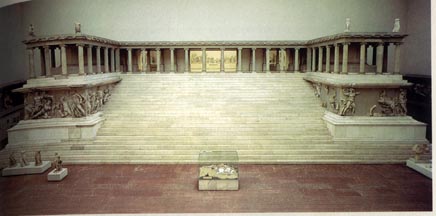 Altar
of Zeus to the south, and made a new Propylaia or gateway to give a slanting
view of the temple of Athena from the landward side.
Altar
of Zeus to the south, and made a new Propylaia or gateway to give a slanting
view of the temple of Athena from the landward side.
Pergamon was to be an Athens in the East. Attalos' victory over the Gauls was to be regarded as a triumph of Greeks over barbarians like the Athenian triumph over the Persians. So the Altar of Zeus was the Parthenon of the Pergamenes; and the temple of Athena, which could not carry this symbolism, was yet given a resemblance to the Parthenon when the gateway was built, because a similar slanting view faced the spectator when he emerged from the Parthenon gateway on the Athenian Acropolis. [There was a copy of the Athena Parthenos in the Library in Pergamon]
Attalos I sowed the seeds of this grandiose development.... He was founder of the library, he set up on the Acropolis at Athens a monument commemorating his victory over the Gauls.... The monument which he erected in Pergamon to commemorate his victory over the Gauls is known from Roman copies and can be reconstructed....
The Attalids interest in Athens is today most visibly evident in the reconstructions of the Stoa of Attalos II in the Agora of Athens.
Small Gallic Group. Copies of figures from a Gallic victory monument set up on the Acropolis in Athens by Attalos I in the later 3rd c. B.C. Pausanias I.25.2: "By the south wall (of the Athenian Acropolis), Attalos dedicated a) the legendary battle of the Giants [top right]..., b) the battle of the Athenians against the Amazons[bottom right], c) the battle against the Persians at Marathon [bottom left]; d) the destruction of the Gauls in Mysian --each figure being about two cubits [=3'].
Reconstruction of monument commemorating the victory over the Gauls by Attalos I, probably in the 220's B.C.
"Ludovisi Gaul and Wife"
Dying Gaul
Temple of Aphaia at Aegina, c. 480 B.C.
The Great Altar of Zeus of Pergamon
possibly constructed during the reign of Eumenes II (197-159 B.C.)
Laocoon, (Trojan priest Laocoon and two sons attacked by giant serpents. 2nd century BCE or 1st century CE. Pliny (Natural History, 36:37) describes the group as being in the house of the emperor Titus and he attributes the work to Hagesander, Polydoros, and Athenedorus of Rhodes. A dining grotto made for the Emperor Tiberius in Sperlonga contains a remarkable group of gigantic sculptures. On the prow of a ship in this group the names of Hagesander, Polydoros, and Athenedorus of Rhodes appear. The Laocoon group was discovered in Rome in 1506 and seen by Michelangelo.

